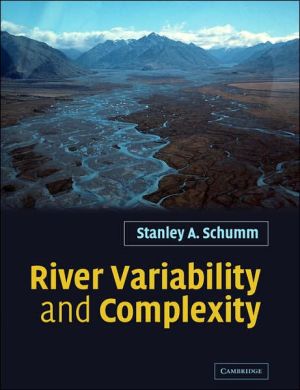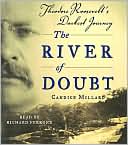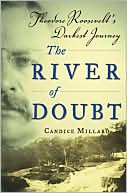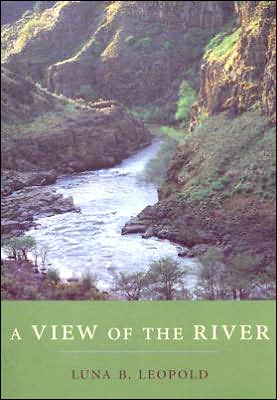River Variability and Complexity
Rivers differ among themselves and through time. An individual river can vary significantly downstream, changing its dimensions and pattern dramatically over a short distance. If hydrology and hydraulics were the primary controls on the morphology and behaviour of large rivers, we would expect long reaches of rivers to maintain characteristic and relatively uniform morphologies. In fact, this is not the case - the variability of large rivers indicates that other important factors are...
Search in google:
Supplementary reading for students and researchers on the factors behind river variability.
\ Cambridge University Press\ 0521846714 - River Variability and Complexity - by Stanley A. Schumm\ Excerpt\ \ \ \ \ Part I\ Background\ \ \ \ \ \ \ Chapter I\ \ \ \ Introduction\ Upon having some astronomical phenomena explained to him, Alfonso X, King of Castile and Leon (1252-84) exclaimed,\ If the Lord Almighty had consulted me before embarking upon creation, I should have recommended something simpler\ (Mackay, 1991)\ River engineers and geomorphologists might well have a similar opinion especially when it is recognized how variable a river can be through time and from reach to reach. However, when Leopold and Maddock published US Geological Survey Professional Paper 252 it was a landmark occasion. Geologists and geomorphologists suddenly became aware of order in rivers, although engineers with their regime equations had anticipated these hydraulic geometry relations. The hydraulic geometry relations of width, depth, and velocity were immediately of value in prediction of river characteristics. However, some of us neglected to recognize how variable the relations were and how significant was the scatter about the regression lines. This should have warned us that, yes, in a general sense channel width increased downstream as the 0.5 power of discharge, but a prediction of what the width was around the next bend could be in gross error, and, therefore recognizing this variability could be of considerable practical significance.\ River characteristics vary sometimes little and sometimes greatly. Reaches are singular because of the numerous variables acting that prevent a single variable, discharge, from dominating river morphology and behavior. The question to be answered is why is one reach of a river connected to a different type of reach? That is, why can reaches be so different? For example, why does a straight river become meandering and a meandering river braid or anabranch? An understanding is critical to the practical application of river data.\ Recently, books dealing with this fluvial variability have been edited (Gregory, 1977; Schumm and Winkley, 1994; Gurnell and Petts, 1995; Miller and Gupta, 1999). Most of the literature dealing with river variability and change has involved what have been referred to as alluvial rivers or alluvial adjustable rivers, and these have been grouped into braided, meandering, and straight. However, more recently considerable attention has been devoted to the study of steep mountain streams and the effects of bedrock (Tinkler and Wohl, 1998).\ A modern alluvial river is one that flows on and in sediments transported by the river during the present hydrologic regime, but it is associated with an older sediment complex at depth. Alluvial rivers have always played an important role in human affairs. All of the early great civilizations rose on the banks of large alluvial rivers such as the Nile, Indus, Yellow, Tigris, and Euphrates. River engineering began in those early times to minimize the effects of floods and channel changes. Today, engineers face the same problems, and they have been successful in developing flood control, navigation, and channel stabilization programs but often at great cost and with the need to continually maintain and repair structures and channels.\ In order to manage alluvial rivers, an understanding of their complexity in space and through time is necessary. They differ in three ways:\ \ \ 1.\ there is a spectrum of river types that is dependent upon hydrology, sediment loads, and geologic history (in other words, rivers differ among themselves);\ \ \ 2.\ rivers change naturally through time as a result of climate and hydrologic change;\ \ \ 3.\ there can be considerable variability of channel morphology along any one river, as a result of geologic and geomorphic controls (Schumm and Winkley, 1994).\ \ \ Information on these differences, especially the last two, will aid in predicting future river behavior and their response to human activities.\ An important consideration in predicting future river behavior and response is the sensitivity of the channel. That is, how readily will it respond to change or how close is it to undergoing a change without an external influence? For example, individual meanders frequently develop progressively to an unstable form, and a chute or neck cutoff results, which leads to local and short-term channel adjustments. The cutting off of numerous meanders along the Mississippi River caused dramatic changes, as a result of steepening of gradient, which led to serious bank erosion and scour (Winkley, 1977).\ Because of this complexity the stratigrapher-sedimentologist, who must interpret ancient valley-fill and alluvial plain deposits, faces a great challenge. For example, many fluvial successions will display characteristics of more than one type of river. This is not "sedimentological anarchy," as suggested by Walker (1990), but it is a recognition of the complexity and variability of fluvial systems in space and time (Miall, 1996, p. 202).\ If the sedimentologist-stratigrapher is concerned with the vertical third dimension of an alluvial deposit, the river engineer and geomorphologist is essentially concerned with the two-dimensional surface of the valley fill.\ The term fluvial is from the Latin word fluvius, a river. When carried to its broadest interpretation a fluvial system not only involves stream channels but also entire drainage networks. The size of fluvial systems ranges from that of the vast Mississippi, Missouri, and Ohio river system to small badland watersheds of a few square meters. The time periods that are of interest to the student of the fluvial system can range from a few minutes of present-day activity, to channel changes of the past century, to the geologic time periods required for the development of the billion-year-old gold-bearing paleo-channels of the Witwatersrand conglomerate and even older and spectacular channels and drainage networks on Mars. Therefore, the range of temporal and spatial dimensions of the fluvial system is very large.\ In order to simplify discussion of the complex assemblage of landforms that comprise a fluvial system, it can be divided into three zones (Figure 1.1). Zone 1 is the drainage basin, watershed, or sediment-source area. This is the area from which water and sediment are derived. It is primarily a zone of sediment production, although sediment storage does occur there in important ways. Zone 2 is the transfer zone, where, for a stable channel, input of sediment can equal output. Zone 3 is the sediment sink or area of deposition (delta, alluvial fan). These three subdivisions of the fluvial system may appear artificial because obviously sediments are stored, eroded, and transported in all the zones; nevertheless, within each zone one process is dominant.\ \ Figure 1.1 Idealized sketch showing the components of the fluvial system. See text for discussion (after Schumm, 1977).\ Image not available in HTML version\ \ Figure 1.2 Chart showing various controls of river morphology and behavior (after Piégay and Schumm, 2003).\ Image not available in HTML version\ \ Each zone, as defined above, is an open system. Each has its own set of morphological attributes, which can be related to water discharge and sediment movement. For example, the divides, slopes, floodplains, and channels of Zone 1 form a morphological system. In addition, the energy- and materials-flow form another, that of a cascading system. Components of the morphological system (channel width, depth, drainage density) can be related statistically to the cascading system (water and sediment movement, shear forces, etc.) to produce a fluvial process-response system.\ The fluvial system can be considered at different scales and in greater or lesser detail depending upon the objective of the observer. For example, a large segment, the dendritic drainage pattern is a component of obvious interest to the geologist and geomorphologist (Figure 1.1a). At a finer scale there is the river reach of Figure 1.1b, which is of interest to those who are concerned with what the channel pattern reveals about river history and behavior, and to engineers who are charged with maintaining navigation and preventing channel erosion. A single meander can be the dominant feature of interest (Figure 1.1c), which is studied by geomorphologists and hydraulic engineers for information that it provides on flow hydraulics, sediment transport, and rate of bend shift. Within the channel itself is a sand bar (Figure 1.1c), the composition of which is of concern to the sedimentologist, as are the bed forms (ripples and dunes) on the surface of the bar (Figure 1.1d) and the details of their sedimentary structure (Figure 1.1e). This, of course, is composed of the individual grains of sediment (Figure 1.1f) which can provide information on sediment sources, sediment loads, and the feasibility of mining the sediment for construction purposes or for placer deposits.\ \ Figure 1.3 Index map showing location of many rivers in the mid-continent USA that are discussed in this volume.\ Image not available in HTML version\ \ As the above demonstrates, a variety of components of the fluvial system can be investigated at many scales, but no component can be totally isolated because there is an interaction of hydrology, hydraulics, geology, and geomorphology at all scales. This emphasizes that the entire fluvial system cannot be ignored, even when only a small part of it is under investigation. Furthermore, it is important to realize that although the fluvial system is a physical system, it follows an evolutionary development, and it changes through time. Therefore, there are a great variety of rivers in space, and they change through time in response to upstream (Figure 1.1a, Zone 1) and downstream (Zone 3) controls.\ Figure 1.2 provides an outline of this book as it lists the variables that determine river type and reach variability and Figure 1.3 shows the location of many US rivers that are discussed later. Three types of control determine what happens at a reach: (1) general controls determine the type of river (braided, meandering, anastomosing, wandering); and (2) the downstream control of base-level and length modify the effects of the general controls. At the reach scale, however, (3) local controls can dominate. They can be fixed in the sense that their position changes little or they can be variable changing in location and time.\ As noted above, it is important to recognize how these variables control river behavior and valley-fill sedimentology. This awareness may aid the engineer in his plans and the sedimentologist in his interpretation of fluvial sediments.\ Human activity takes place everywhere (Figure 1.2), but these impacts will not be considered, except as an upstream control (Figure 1.2), as they are usually obvious. For example, riprap, dikes, diversions, etc. can be constructed anywhere, and they are fully discussed in the engineering literature (Peterson, 1986) and by experts in the field of human impacts on rivers (Brizga and Finlayson, 1999; Wohl, 2000a; Anthony et al., 2001). Nevertheless, human involvement with rivers for better or worse is considered in Part (Chapters 18, 19, and 20).\ \ \ \ Chapter 2\ \ \ \ Types of rivers\ Before considering the variability of a single river, it is necessary to consider the different types of rivers that exist (Table 2.1). Once a topic is sufficiently comprehended, it appears logical to develop a classification of its components. A classification can provide a direction for future research, and there have been many attempts to classify rivers (e.g., Schumm, 1963; Mollard, 1973; Kellerhals et al., 1976; Brice, 1981; Mosley, 1987; Rosgen, 1994; Thorne, 1997; Vandenberghe, 2001). Indeed, Goodwin (1999) thinks that there is an atavistic compulsion to classify, and indeed, an individual's survival may depend on an ability to distinguish different river types (deep versus shallow).\ Depending upon the perspective of the investigator, a classification of rivers will depend upon the variable of most significance. For example, the classic braided, meandering and straight tripart division of rivers (Leopold and Wolman, 1957) is based upon pattern with boundaries among the three patterns based upon discharge and gradient. Brice (1982, 1983) added an anabranched or anastomosing channel pattern (Figure 2.1) to the triad and distinguished between two types of meandering channels (Table 2.1). The passive equiwidth meandering channel is very stable as compared to the wide-bend point-bar meandering channel (Figure 2.2). This is a very important practical distinction between active and passive meandering channels (Thorne, 1997, p. 188). A highly sinuous equiwidth channel gives the impression of great activity whereas, in fact, it can be relatively stable (Figure 2.3). Brice also indicates how width, gradient, and sinuosity, as well as type of sediment load and bank stability varies with pattern (Figure 2.2).\ Based upon examination of sand-bed streams of the Great Plains (Kansas, Nebraska, Wyoming, Colorado), USA, and the Murrumbidgee River, Australia, Schumm (1968) proposed a three-part division of rivers based upon type of sediment load and channel stability (Table 2.2). The bed sediment in these channels did not vary significantly; therefore, grain size was not related to channel morphology, but type of load (suspended, mixed, or bed-material) was.\ There are five basic bed-load channel patterns (Figure 2.4) that have been recognized during experimental studies. These five basic bed-load channel patterns can be extended to mixed-load and suspended-load channels to produce 13 patterns (Figure 2.4). Patterns 1-5 are bed-load channel patterns as defined in Table 2.2. Patterns 6-10 are mixed-load channel patterns, and patterns 11-13 are suspended-load channel patterns. The patterns change with increasing valley slope, stream power, and sediment load for each channel type.\ \ \ \ \ © Cambridge University Press
Preface; Acknowledgements; Part I. Background: 1. Introduction; 2. Types of rivers; 3. Non-regime channels; Part II. Upstream Controls: 4. History; 5. Tectonics and relief; 6. Lithology; 7. Climate: hydrology; 8. Humans; Part III. Fixed Local Controls: 9. Bedrock: alluvium; 10. Tributaries; 11. Active tectonics; 12. Valley morphology; Part IV. Variable Local Controls: 13. Floods; 14. Vegetation; 15. Accidents; Part V. Downstream Controls: 16. Base-level; 17. Length; Part VI. Rivers and Humans: 18. Applications; 19. Some unintended consequences; 20. River impact on ancient civilisations: a hypothesis; References; Index.








